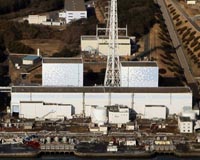 |
Tokyo (UPI) Mar 15, 2011 Japan's nuclear crisis continues to unfold after a fourth explosion Tuesday at the Fukushima nuclear plant was followed by a fire at a spent fuel pond, releasing radiation into the atmosphere. Two of the reactors at the plant, 170 miles north of Tokyo, crippled after last Friday's earthquake and tsunami, had been damaged by blasts Saturday and Monday. In a report dated Wednesday, Kyodo News said the latest blast occurred at the No. 4 reactor Tuesday morning, creating two square-shaped holes, approximately 26 feet by 26 feet, in the walls of the building that houses the reactor. Later, a fire broke out, smoke billowing from the holes. That followed a "critical situation" at the No. 2 reactor -- an "apparent hydrogen explosion"-- that had occurred four minutes earlier, damaging a portion of the reactor's containment vessel, Kyodo said. The No. 4 reactor houses the spent fuel rods. Normally, those fuel rods are immersed in cold water because they need to be cool for three or four years after they have been used in one of the other three reactors, BBC reported. In a televised address Tuesday, Japanese Prime Minister Naoto Kan called for calm. "There is still a very high risk of further radioactive material coming out," Kan said. "The people at the power plant are carrying out an operation to inject water to cool the reactors and I would like to ask the nation, that although this is an incident of great concern, I request that you act very calmly." However, because of high levels of radiation at the No. 4 reactor following the blast, workers weren't able to prepare for the pouring of water into the distressed pool, Kyodo reports. Plant operator Tokyo Electric Power Co. said it would attempt to pour water into the facility Wednesday via the holes that were created during the blast, Kyodo reports. Later Tuesday, Japanese Chief Cabinet Secretary Yuko Edano said radiation levels had decreased. "Radiation levels monitored near the front gate of the plant as of 9 a.m. were 11,930 microsieverts, a very high level. At 3:30 p.m. this came down to 496.4, much higher than a normal level but still a level to cause no harm to human health," he told reporters. Kyodo reported that Toshiba Corp. had sent "dozens" of its engineers to the plant at the request of the government and TEPCO amid rising fears of radioactive contamination. They are to instruct plant workers on the usage of pumps to inject water into the plant's reactors. Toshiba had supplied much of the equipment for the plant's reactors, Kyodo said. "As some of these (cooling) efforts fail, the options, of course, become limited," Reza Hashemi-Nezhad, the director of the Institute of Nuclear Science at the University of Sydney told The Australian newspaper. Hashemi-Nezhad said that any structural damage to reactor No. 2 was a worrying development and described the reported levels of radiation released at the plant as being of concern. But it was unlikely, he said, that any leakage of radiation would be as serious as the Chernobyl disaster of 1986.
Share This Article With Planet Earth
Related Links Bringing Order To A World Of Disasters A world of storm and tempest When the Earth Quakes
 'Rigged' cooling may fail at Japan nuke plant: US scientist
'Rigged' cooling may fail at Japan nuke plant: US scientistWashington (AFP) March 15, 2011 If radiation levels continue to rise around Japan's earthquake-hit nuclear facilities, all remaining workers would have to evacuate and attempts to manually cool the reactor could fail, US scientists said Tuesday. Only about 50 nuclear workers have stayed behind to douse the stricken reactors with sea water and authorities were mulling using water-dropping helicopters as the crisis at the ag ... read more |
|
| The content herein, unless otherwise known to be public domain, are Copyright 1995-2010 - SpaceDaily. AFP and UPI Wire Stories are copyright Agence France-Presse and United Press International. ESA Portal Reports are copyright European Space Agency. All NASA sourced material is public domain. Additional copyrights may apply in whole or part to other bona fide parties. Advertising does not imply endorsement,agreement or approval of any opinions, statements or information provided by SpaceDaily on any Web page published or hosted by SpaceDaily. Privacy Statement |